NGC 6888, Crescent Nebula in Cygnus
Another night out with the Optolong l-eXtreme dual narrowband filter, and again, I'm really surprised at the color and detail captured with the two 7nm band passes, one around 504nm for OIII and the second at 656nm for hydrogen-alpha. Star colors look pretty good, and overall this is closer to true color (red and blue generally where they're supposed to be) than hubble palette SHO images. I captured 55 subs at 300 seconds (5 minutes) each, but threw out all but 28 for processing--it was really windy last night and that just throws chaos into tracking and guiding. I have been doing narrowband imaging with monochrome cameras and separate filters for each bandpass for almost a decade, and that's still my preferred method for capturing deep sky objects like the Crescent, but it's also really promising what you can capture with a cooled color camera in one imaging session.

Cropped to NGC 6888:
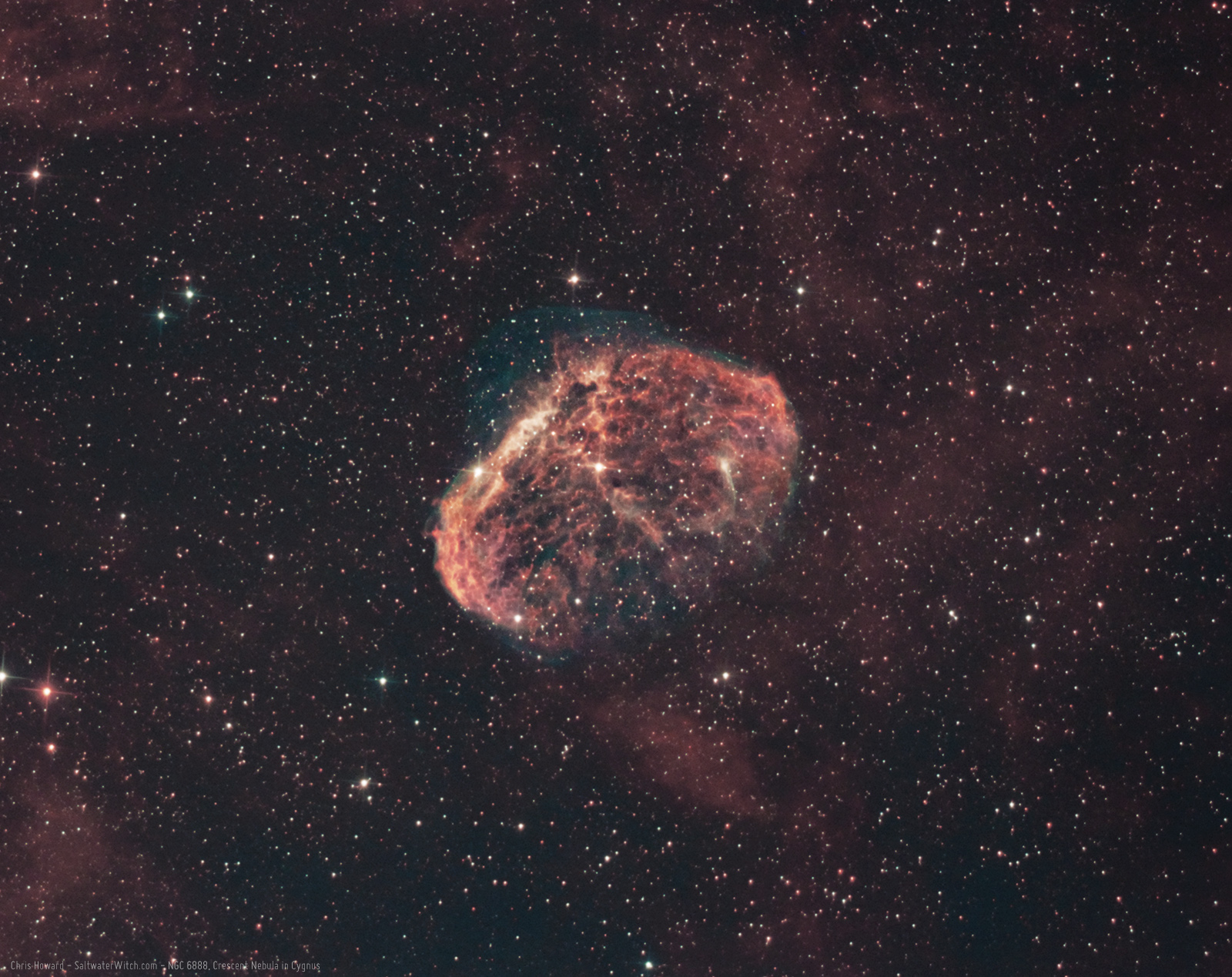
Posted May 18, 2023
NGC 7000 in Cygnus
I bought the Optolong L-eXtreme dual narrowband filter last year, but I haven't seriously used it until last night. Paired with the ZWO ASI071 and the 800mm f/4 Newtonian, I am pleasantly surprised with the data and processed image. The North America Nebula (NGC 7000) in the constellation Cygnus hit 30° above the horizon around midnight, and I spent over 3.5 hours capturing data, 45 x 300-second exposures stacked in DSS. This has to be the most efficient way to get to a bi-color narrowband image, using a single filter and color astronomy camera. These colors are also close to true in terms of where they are on the visible spectrum, with hydrogen-alpha in red and oxygen III in blue.

Posted May 14, 2023
Tangled clouds in Cygnus
There's a lot going on in this detailed look at one tiny section of the vast network of interstellar dust and clouds of hydrogen in the constellation Cygnus, including the open star clusters NGC 6871, NGC 6883 and a handful of dark nebulae including Barnard 147 (LDN 853, the pointy dark channel of dust a little left of center), B146, LDN 856, 858. Notes: 28 x 8-minute exposures, almost four hours of data in hydrogen-alpha (Antlia 3nm Ha Pro filter), William Optics GT81 Apochromatic refractor 382mm FL at f/4.7, ZWO ASI1600MM-Pro mono camera cooled to -10C.

Cygnus Composite - I combined images from two different scopes, all the data for the wide field view (left) came from my William Optics GT81, and I captured the data for the Tulip Nebula (Sh2-101, right) with the Apertura 8"/203mm Newtonian.

Posted November 4, 2022
Narrowband Boogeyman in Orion
Sure, we're a few days late for halloween, but check out the creepiness of the dark molecular cloud LDN1622, the "Boogeyman Nebula" about 500 lightyears away in the constellation Orion, along with a bright lumpy backdrop of nebulosity lit from above by the variable star 56 Orionis. LDN1621 is the dark nebula to the left of the Boogeyman, and the reflection nebula VdB 62 is just to the right. The uneven cloudiness at the top right is a small section of Barnard's Loop (Sh2-276), which may give you an indication of LDN1622's location, on the other side of the Loop from M78, about halfway up one side of Orion. Notes: 36 x 8-minute exposures, almost five hours of data in hydrogen-alpha (Antlia 3nm Ha Pro filter), William Optics GT81 Apochromatic refractor 382mm FL at f/4.7, ZWO ASI1600MM-Pro mono camera cooled to -10C.

Posted November 4, 2022
M78 in RGB
I swapped out the narrowband EFW with the RGB+Ha filters, and ran through RGB for Messier 78 (NGC 2068), a reflection nebula in Orion. I also experimented with 2x2 binning with the ZWO ASI1600MM-Pro mono camera, and it taking the resolution from 0.98 arcseconds/pixel to 1.96" / pixel worked pretty well.
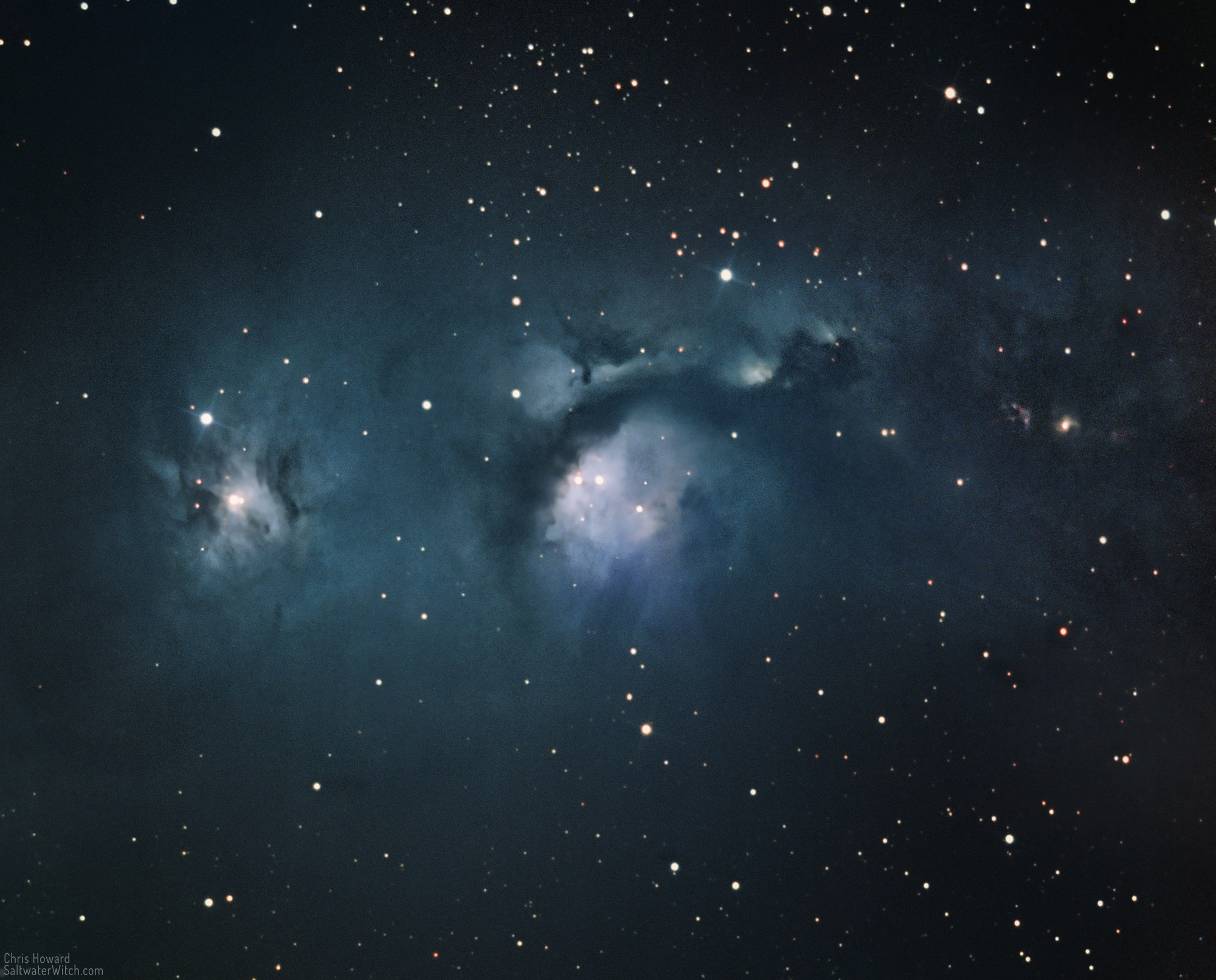
Posted October 30, 2022
A few more from this run of clear October skies
A few more processed (to some degree) images from the data I have gathered over the last five clear nights. Gear notes: I captured all the data for these in my backyard with an Apertura 800mm f/4 Newtonian OTA, ZWO ASI1600MM-Pro mono camera, Antlia 3nm filters, ZWO ASI290M OAG, on the Sky-Watcher EQ6R-Pro mount with the ZWO ASIAir Plus controller.
The core of the Heart Nebula (IC 1805) in Ha+OIII with the star cluster, Melotte 15 surrounding coils and branches of interstellar dust and gas.
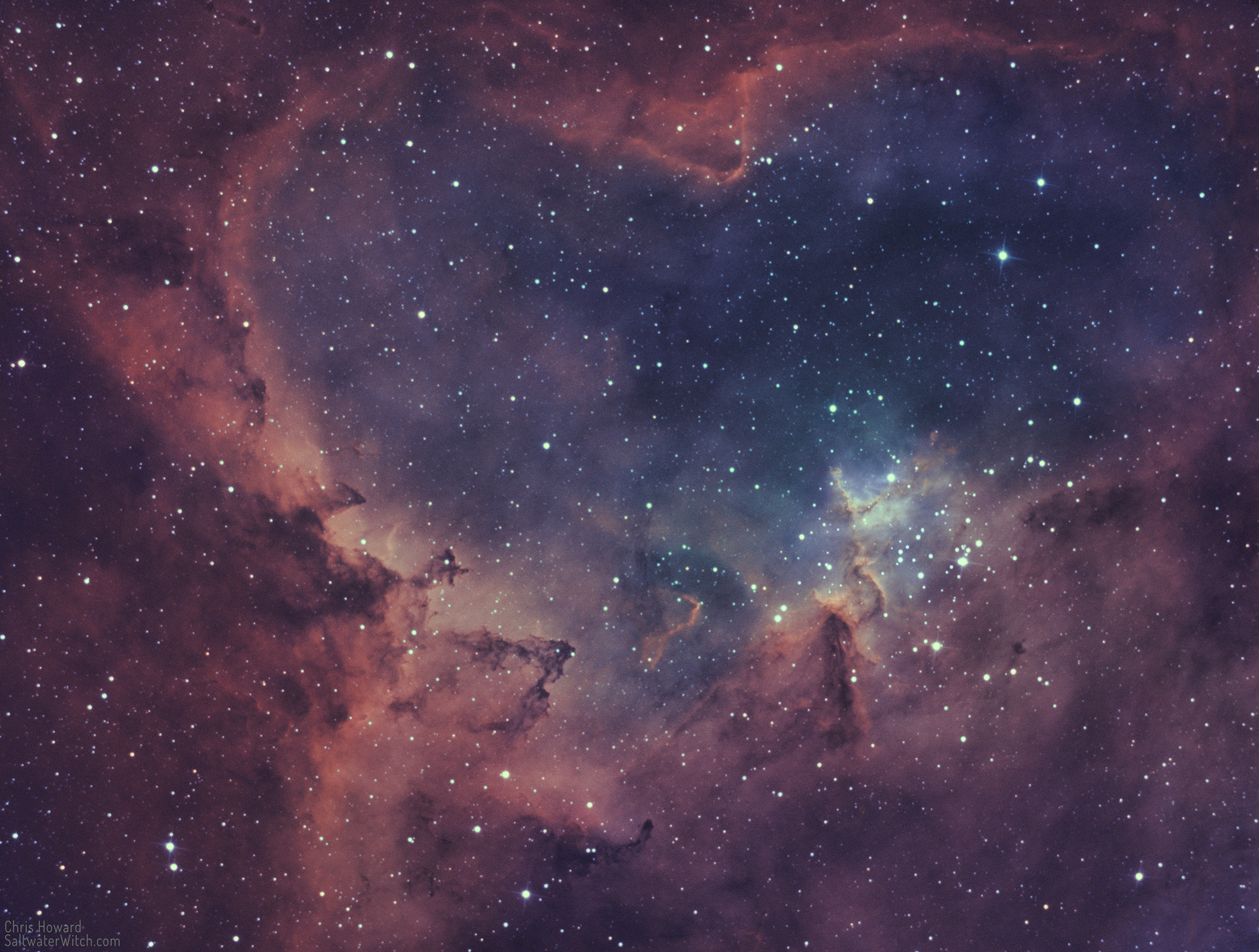
Here's the Tulip Nebula (Sharpless 101) in Ha + OIII, a very energetic HII region about 6000 lightyears away in the constellation Cygnus.
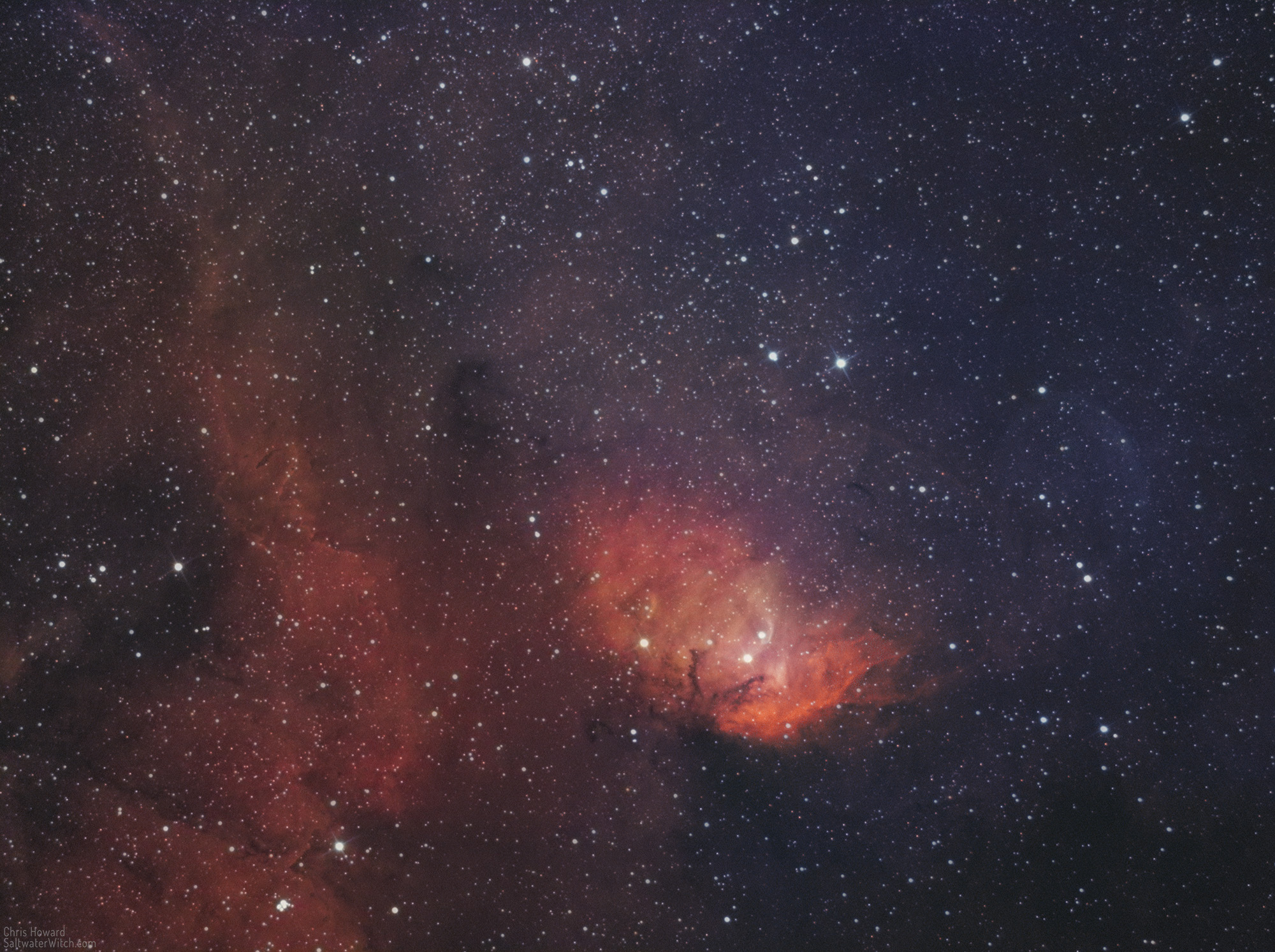
The Jellyfish Nebula (IC 443, Sharpless 248) in hydrogen-alpha. IC 443 is a (Sh2-248)) is a supernova remnant about 5000 lightyears away in the constellation Gemini. Trailing off, out of frame top left, is the HII region Sharpless 249. There's ongoing research to determine if these two interact, but they probably do not. SH2-249 is most likely further away than the IC 443 supernova remnant. [https://ui.adsabs.harvard.edu/abs/1984A%26A...140..395D]
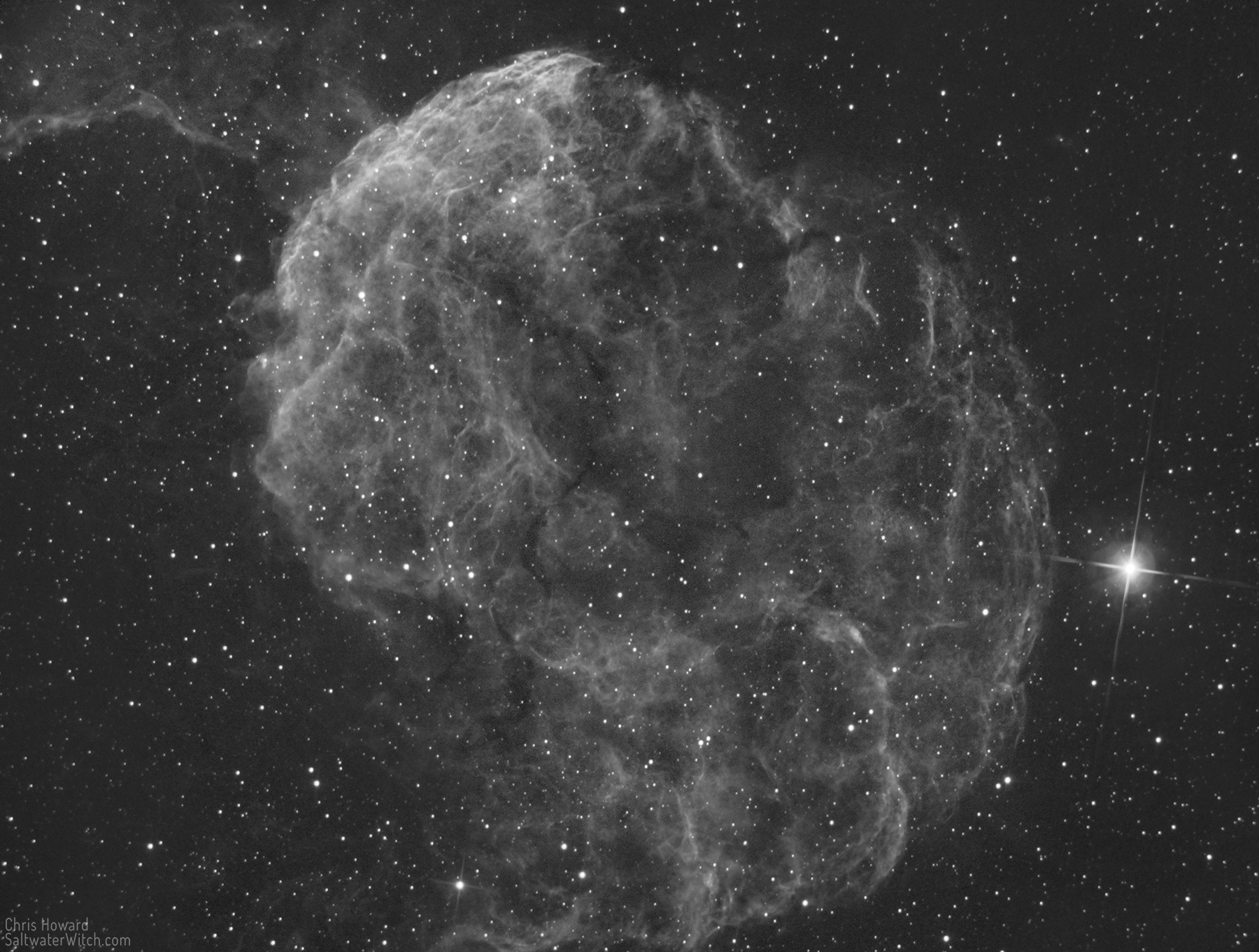
Posted October 23, 2022
M42 up close in Ha
The Orion, De Mairin and Running Man Nebulas (M42, M43, NGC 1977) in narrowband hydrogen-alpha. 36 x 300-second exposures, Newtonian 800mm @ f/4.

Posted October 22, 2022
The Rosette in Ha
The Rosette Nebula (Sh2-275, Caldwell 49) is an HII region and star forming complex in the constellation Monoceros, about 5,200 lightyears away and about 130 lightyears across. The dark chain of interstellar gasses and dust along the bottom is punctuated with Bok Globules, dense regions of star formation. The open cluster of massive blue stars in the center (NGC 2244) are responsible for ionizing the surrounding hydrogen, oxygen, and other gasses; bathed in the intense radiation from these stars, the clouds themselves emit light. These giant stars originally formed out of the nebula and they're now in the process of hollowing out the cloud structure and creating the bubbles of ionization visible around the nebula's core.

